英语应用语言学论文,英文论文
- 格式:docx
- 大小:46.04 KB
- 文档页数:12
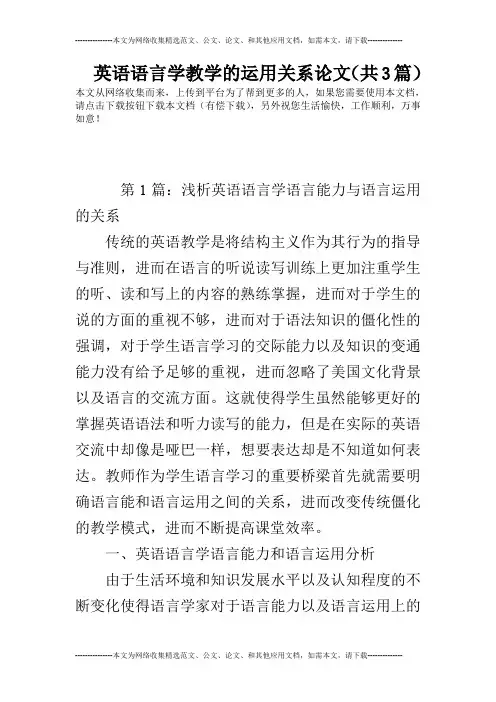
英语语言学教学的运用关系论文(共3篇)本文从网络收集而来,上传到平台为了帮到更多的人,如果您需要使用本文档,请点击下载按钮下载本文档(有偿下载),另外祝您生活愉快,工作顺利,万事如意!第1篇:浅析英语语言学语言能力与语言运用的关系传统的英语教学是将结构主义作为其行为的指导与准则,进而在语言的听说读写训练上更加注重学生的听、读和写上的内容的熟练掌握,进而对于学生的说的方面的重视不够,进而对于语法知识的僵化性的强调,对于学生语言学习的交际能力以及知识的变通能力没有给予足够的重视,进而忽略了美国文化背景以及语言的交流方面。
这就使得学生虽然能够更好的掌握英语语法和听力读写的能力,但是在实际的英语交流中却像是哑巴一样,想要表达却是不知道如何表达。
教师作为学生语言学习的重要桥梁首先就需要明确语言能和语言运用之间的关系,进而改变传统僵化的教学模式,进而不断提高课堂效率。
一、英语语言学语言能力和语言运用分析由于生活环境和知识发展水平以及认知程度的不断变化使得语言学家对于语言能力以及语言运用上的定义就有一定的出入。
在二十世界发展的早期,著名的语言学家索绪尔曾经对于“语言”和“言语”之间的概念进行了辨析,进而提出了语言与语言的管理存在很大的关系,也就是说语言能力是对于词汇、发音以及语法等硬性知识的掌握而进行的概括,并且语言可以被看作是言语在实际的社会活动之中的一种交流媒介,这是不经受人的意志上的支配,而是社会人员的一种基础的社会心理现象;但是言语则是对于语言的实际性运用,是每一个人的自由性的活动,其行为是受到自身的意志的支配,进而支配其在社会生活中能够运用语言的知识和语言的规则。
相反,通过对于言语的记录就能够实现对于语言的基本机构和形态的分析来举一反三的总结出该语言的实际使用规则。
语言并不是只是依靠后天的学习就能够获得的,还需要人类在先天就与之而来语言的学习能力的刺激才能够达到,这种能力由于后天的生活环境的影响就会使其内在的知识结构发生很大的改变,进而出现了所谓的语言能力和语言运用的区别。
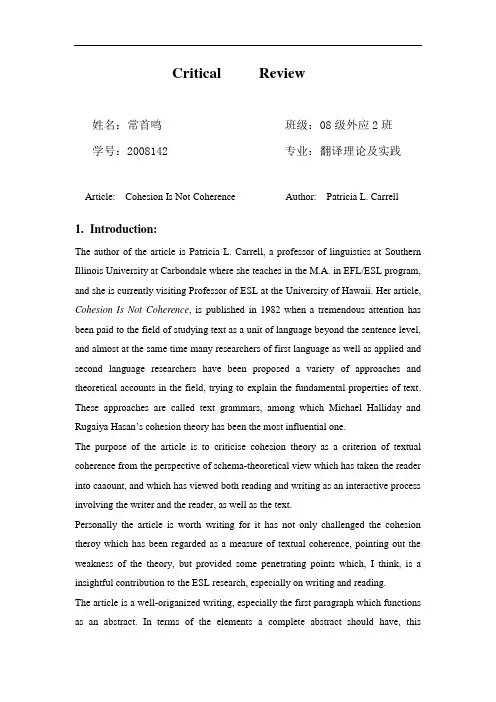
Critical Review姓名:常首鸣班级:08级外应2班学号:2008142 专业:翻译理论及实践Article: Cohesion Is Not Coherence Author: Patricia L. Carrell1.Introduction:The author of the article is Patricia L. Carrell, a professor of linguistics at Southern Illinois University at Carbondale where she teaches in the M.A. in EFL/ESL program, and she is currently visiting Professor of ESL at the University of Hawaii. Her article, Cohesion Is Not Coherence, is published in 1982 when a tremendous attention has been paid to the field of studying text as a unit of language beyond the sentence level, and almost at the same time many researchers of first language as well as applied and second language researchers have been proposed a variety of approaches and theoretical accounts in the field, trying to explain the fundamental properties of text. These approaches are called text grammars, among which Michael Halliday and Rugaiya Hasan’s cohesion theory has been the most influential one.The purpose of the article is to criticise cohesion theory as a criterion of textual coherence from the perspective of schema-theoretical view which has taken the reader into caaount, and which has viewed both reading and writing as an interactive process involving the writer and the reader, as well as the text.Personally the article is worth writing for it has not only challenged the cohesion theroy which has been regarded as a measure of textual coherence, pointing out the weakness of the theory, but provided some penetrating points which, I think, is a insightful contribution to the ESL research, especially on writing and reading.The article is a well-origanized writing, especially the first paragraph which functions as an abstract. In terms of the elements a complete abstract should have, thisparagraph could be a model writing on the level of both structure and logic.2.Body2.1 On the Introduction Part of This Articlethe writer clearly and concisely reviews the background information that Halliday and Hasan proposed the concept of cohesion, and shows the organization of her article: the first part reviews Halliday and Hasan’s cohesion theory as a criterion of textual coherence; the scond part criticizes the cohesive view of coherence both theoretically and empirically; the third and final part relates this criticism of cohesion as a measure of coherence to the applied fiel d—the teaching of writing and reading in a second language, especially ESL.2.2On Reviewing Cohesion TheoryCarrell objectively and fairly describes cohesion theory and categorise it as the traditional text grammar. The theory treats text in the field of linguistics. After pointing out that register and cohesion, the letter of which is Halliday and Hasan’s main concern, are the combination of coherence, or texture which establishes what is the properities of texts in English, and what it is that distinguishes a text from a disconnected sequence of sentence, the author stating that cohesion concerns semantic relations rather than content of passeges or textual meaning; and then she briefly summarizes the four cohesive ties or relations—reference, substituation, conjunction and lexical cohesion—which Halliday and Hasan believe to be the resources for creating texture, or coherence.Finally Carrell concludes that Halliday and Hasan’s mian point appears to be that coherence of content alone is not enough to produce a coherent text, and there must be some additional device, such as ochesive ties, to make a text coherent.2.3On The Criticism Of The Cohesive View Of Coherence2.3.1 From the Theoretical ConsiderationsCarrell has briefly reviewed the criticism towards the cohesion view of textual coherence from different perspectives, such as that of Karen Feathers’ which arguesthat cohesion theory operates on the superfical surface structure of a text in establishing the cohesive ties.However the criticism of this article is in line with schema-theoretical views of text processing. The theoretical criticism emanates from Morgan and Sellner’s opinion. They sharply state that text grammars, including cohesion theory, talk about text analisis just for the sake of linguistic analysis for these approaches ignore a crucial and indispensable element in the text processin g—reader. Language is the reflection of the real world, and text is produced for reader.From the point of schems-theory, Morgan and sellner argue that Halliday and Hasan mistakingly take certain aspects of linguistic forms, namely cohesive ties as the cause, not the effect, of coherence. To convince the suggestion, they examine the first and simplest example in Halliday and Hasan’s book, Cohesion in English published in 1975. And then they state that Halliday and Hasan provide no reason in their notion. In the end, Carrell maintains the idea that text coheres not because the existence ofo lexical cohesive ties, but because readers have access to interpreting the schems in text. Without such a schems text will fail to cohere.2.3.2 From Empirical StudiesOn the empirical criticism part, Carrell uses three separate empirical studies to support Morgan and Sellner’s theoretical criticism of Halliday and Hasan’s notion. The first study carried out by Tierney and Mosenthal is to examine the extent to which Halliday and Hasan’s cohesion concept correlated with coherence. They find that toic or content appears to affect the writer’s choice in using cohesive ties. The study indicates that a cohesion index is causally unrelated to a text’s coherence. The second experiment by Freebody and Anderson shows the effects of three different levels of cohesion on reaers’understanding of written texts. The experiment also indicates that vocablary difficulty had a dramatic effect on understanding, but the amount of cohesion did not. The last empirical study by Steffensen who studied the interactive effects of both cohesive ties and cultural background knowledge on readers’comprehension of short prose texts. Steffensen found that causal and adversaitve cohesive elements were recalled better by readers from the text of theirown culture than the text of foreign culture. It suggests that cultural elements will cause the loss the textual cohesion. In other words, without the background schema underlying the text the cohesive ties will not produce a coherent text on the part of readers.2.4 Implications For Second Language/ESLThe critical of the paper on cohesiontheory in the light of schema-theory is to caytion those in second language teaching, especially in ESL, not to think that cohesion theory will be a panacea to solve reading and writing problem at the level of text. A coferent text will likely be coheisve, not of necessary, that is only an effect of the coherent content.Cohesion theory is worth studing. However it is not an measure of coherence of a text.2.5EvaluationAfter reading the article, we could gain a clear idea from the well-organized structure. Excellence of the article lies in the methodology used in it, that is, the theoretical criticism supported by the the empirical work which is carried out upon the same theoretical framework. However the limitations of the article are also its strengths. On the theoretical part, the critical opinion mainly comes from other researchers rather than Carrell herself; and on the empirical part, the three separate empirical studies are not finished by Carrell.3.ConclusionThe article criticises the concept of cohesion as a measure of the coherence, pointing out that the notion hold by Halliday and Hasan is in line with the linguistic analysis. With the orientation of schema-theory, the auhtor strongly criticises cohesion theory which fails to take the contribution of readers’into consideration in text processing, and objectively sates that cohesion theory hold by many researchers, especially in second language teaching/ESL, will not be a ultimate solution to writing and reading problem. The article has drawn some critical insight towards the second languageteaching and learning, which has been supported theoretically and empirically. The article is thought provoking.REFERENCES:Bobrow, D. G., and D. A. Norman. 1975. Some principles of memory schemata. In D.G. Bobrow and A. M. Collins ( Eds. ), Representation and understanding:Studies in cognitive science. New York: Academic Press.Carpenter, C., and J. Hunter. 1982. Functional exercises: Improving overall coherence in ESL writing. TESOL Quarterly 15, 4:425-434.Feathers, K. 1981. Text unity: A semantic perspective on mapping cohesion and coherence. Unpublished paper, Indiana University.Freebody, P., and R. C. Anderson. 1981. Effects of vocabulary difficulty, text cohesion, and schema availability on reading comprehension. Technical Report No. 225, Center for the Study of Reading. Champaign, IL: University of Illinois.Fries, C. 1952. The structure of English. New York: Harcourt.Goodin, G., and K. Perkins. 1982. Discourse analysis and the art of coherence.College English 44: 57-63.Hagerup-Neilsen, A. R. 1977. Role of macrostructures and linguistic connective in comprehending familiar and unfamiliar written discourse. Unpublished doctoral dissertation, University of Minnesota.Halliday, M. A. K., and R. Hasan. 1976. Cohesion in English. London: Longman. Harris, Z. 1970. Papers in structural and transformational linguistics. Dordrecht: D.Reidel.Hasan, R. 1978. On the notion of a text. In J. S. Petöfi (Ed.), Text vs. sentence.Hamburg: H. Buske.Kintsch, W. 1974. The representation of meaning in memory. Hillsdale, NJ: Lawrence Erlbaum Associates.Levy, D. M. 1979. Communicative goals and strategies: Between discourse and syntax.In T. Givon (Ed.), Syntax and semantics, Vol. 12: Discourse and syntax. New York: Academic Press.Longacre, R. 1972. Hierarchy and universality of discourse constituents in New Guinea languages. Washington, DC: Georgetown University Press. Longacre, R. 1968. Discourse, paragraph and sentence structure in selected Philippine languages. Santa Ana, CA: Summer Institute of Linguistics. Mandler, J. M., and N. S. Johnson. 1977. Remembrance of things parsed: Story structure and recall. Cognitive Psychology 9: 111-151.Menke, S. A. 1981. The noun phrase as a cohesive force in English text grammar.Unpublished paper presented at the First Midwest Regional TESOL Conference. Morgan, J. L., and M. B. Sellner. 1980. Discourse and linguistic theory. In R. J. Sp iro, B. C. Bertram, and W. F. Brewer ( Eds. ), Theoretical issues in readingcomprehension. Hillsdale, NJ: Lawrence Erlbaum Associates.Pike, K. 1967. Language in relation to a unified theory of the structure of human behavior. The Hague: Mounton.Rumelhart, D. L. 1975. Notes on a schema for stories. In D. G. Bobrow and A. M.Collins ( Eds. ), Representation and understanding: Studies in cognitive science.New York: Academic Press.Steffensen, M. S. 1981. Register, cohesion, and cross-cultural reading comprehension. Technical Report No. 220, Center for the Study of Reading.Champaign, IL:University of Illinois.Stein, N. L., and C. G. Glenn. 1979. An analysis of story comprehension in elementary school children. In R. O. Freedle (Ed.), Discourse processing: New directions. Norwood, NJ: Ablex.Thorndyke, P. W. 1977. Cognitive structures in comprehension and memory of narrative discourse. Cognitive Psychology 9: 77-110.Tierney, R. J., and J. H,. Mosenthal. 1980. Discourse comprehension and production: Analyzing text structure and cohesion. Technical Report No. 152, Center for the Study of Reading, Champaign, IL: University of Illinois.Tierney, R. J., and J. H. Mosenthal. 1981. The cohesion concept’s relationship to the coherence of text. Technical Report No. 221, Center for the Study of Reading.Champaign, IL: University of Illinois.van Dijk, T. A. 1972. Semantic macro-structures and knowledge frames in discourse comprehension. In M. A. Just and P. A. Carpenter ( Eds. ), Cognitive processes in comprehension. Hillsdale, NJ: Lawrence Erlbaum Associates.van Dijk, T. A. 1977. Text and context. London: Longman.Entry 1 Analyzing Legal Texts Within the Framework of Interpersonal Metafunction in the Context of Translation It is a thesis attempting to discuss translation methods pertaining to power preservation in the English to Chinese translation of legislative text. As a matter of fact, people mainly adopt a linguistic approach to the English to Chinese translation of legislative text with other external factors neglected. As one of the most important external factors, the role of power in legal text translation is stressed by the author in this thesis. The theoretical framework of this thesis is one of Halliday’s metafunctions, the interpersonal function.When I first came across this thesis, I felt a little excited because it is where my own interest lies and the research question is attractive. But to my disappointment, it doesn’t meet my expectation. First, the abstract part is not well organized and clearly stated. After finishing reading this part, I am almost lost. Although the subject matter of the thesis is clearly stated, it lacks research findings. Besides, in the last sentence “the result of the study may provide some implications for legal translation in general’, the writer fails to give the concrete implications of the study. Thus, it leaves its readers in confusion. As for the literature review which is included in the introduction part, it is also not very satisfactory. The author just makes a list of relevant materials and fails to elaborate the basis and premises of the research.Apart from the weakness that I have discussed above, it do does well in some aspect. Take its microstructure for example, it does not only logically arranged but clearly stated as well. Furthermore, this thesis brings a fresh air to legal language studies by adopting the top-down research methodology.The author is suggested to rewrite the abstract part and amplify the literature review. Above all, she is also supposed to clarify her research findings and their implications.In conclusion, from a bird’s-eye view of the whole thesis, it is reasonably arranged and well structured. However, from a worm’s-eye, there are a lot of problems to be rectified.Entry 2 Measuring Textual Equivalence:A Functional Linguistic ApproachThis thesis seeks to explore the contribution of the cohesion theory to the building of textual equivalence in translation practice through resources of the relevant research findings. The research topic of the thesis is the textual equivalence. Under the theoretical framework of the cohesion theory, it clearly states the five variables of cohesion: thematic progression, reference system, ellipsis conjunction, and lexical cohesion. These five variables can be used to evaluate the adequacy of a translated text in terms of equivalence. Thus it provides insight into the evaluation of the translated works.This thesis has given me plenty of enlightenment and suggestions which will contribute a lot to my later study. From the reading of this thesis, I have a deep understanding of what a thesis is supposed be, what an abstract is supposed be, what an introduction is supposed be etc. It aids me to understand what I have learned in class.This thesis is so well written that I almost cannot find any problems in it. Its abstract is a quite standard one. In this part, the author includes almost all the parts that an abstract desires. Its language is concise and clear. It helps its readers have a very clear panoramic view of the whole thesis and fulfill the function of an abstract. It helps me deepen my understanding of what an abstract is supposed to be and sets a good example. Besides, the thesis itself has a sound theoretical framework. It does not only make an introduction of the cohesion theory but elaborate the relationship between the theory and the research topic and process as well. The outline of the thesis is based on the five variables that are used to evaluate the adequacy of a translated text from the perspective of equivalence.Although it is so well structured, there still exists a problem, that is, it does not clearly state the implications of the theory after the case study. I suggest the author add them in her thesis.In a word, this thesis is a good one and we can learn a lot from reading it.Entry 3 The Unit of Translation Revisited:From the perspectives of Analysis and Transference In the domain of translation studies, the study of the unit of translation (UT for short) has been a longstanding academic issue. The research of it is by no means new to us. Additionally, it ranks among the most complicated problems of translation theory and draws great attention of overseas and domestic translation scholars. Thus, it is difficult to do such kind of research. In the history of translation studies, the issue of UT has been addressed from different perspectives. In this thesis, the author makes arduous efforts to clarify the concept of UT and its function and do the research of it from the perspective of textlinguistics and systemic functional grammar which are the theoretical framework of this thesis.As I have mentioned in the introduction, this topic is an old one and a great amount of literature is desired to be made by the author. Actually the author himself is fully aware of it and does a good job. However, the literature review is not perfect because the author puts some parts, which is supposed to be included in the first chapter, in the second chapter. Therefore, it is better for the writer to make some adjustments. As far as the research question is concerned, the author states it clearly and gives a satisfactory solution to it. Although the question is old, its perspective is new and gives its readers a lot of enlightenment.There are still some problems in this thesis. It lies in the aspect of its theoretical framework. It fails to elaborate the relationship between the theory and the research topic and process. And its introduction of the theoretical framework is too briefly stated and beyond satisfaction. Besides, the author does not tell the readers why his evaluation is important and how his study is conducted. And also he does not give readers an outline of his thesis. I strongly recommend him to make one in the introduction part, for it is much easier to familiarize the readers with the structure of his thesis before get down to the body part.In a word, I gain a lot from this academic knowledge filled thesis and it gives me some enlightenment in this research field.Entry 4 The Ideational Grammatical Metaphor:A New Perspective for the Study of Poem TranslationsPublished on the Journal of Jiangnan University in April 2008, the article mainly talks about the experiential metaphor through the analysis of the three translated versions of Wang Wei’s poem “Niao Ming Jian” by Gong Jinghao, Xu Yuanchong and Y e Weilian. As we all known, the studies of Chinese poems translation is a hot issue of studies in recent years and in some universities it has even become one of the major orientation of studies in their graduate schools. That is to say, scholars and the students majoring in translation studies have paid much more attention to the study of poem translations. However, research findings in the respect are comparatively little and the findings in the study of poem translations from the perspective of the ideational grammatical metaphor are even less.After reading the article, I have plenty of enlightenment. It gives us a completely new perspective for better interpretation of a poem in the original and better appreciation of its various translated versions and provides us a new criterion for translation criticism. It shows that the grammatical metaphor could help translators make the most appropriate decisions on diction when they are faced with more than one synonymous choice. It also concludes that the hypothesis of grammatical metaphor has its peculiar advantages in assisting poem translations because the different incongruencies could carry different connotations. It provides insight into the translations of poems.As a whole, this article is well organized and well written, but there still exists some problems. The abstract in this article does not serve its function well because it is too detailed written and too much background knowledge is involved for an article. Besides, there is a blunder in this article, that is, in the reference part all the works cited are in a random order instead of an alphabetical one.As it is a rather new research area, it lacks the foundation of previous studies and its feasibility is to be doubted. Therefore, it is a little bit hard for us to do such kind of research. In our future studies, our greater effort is desired.。
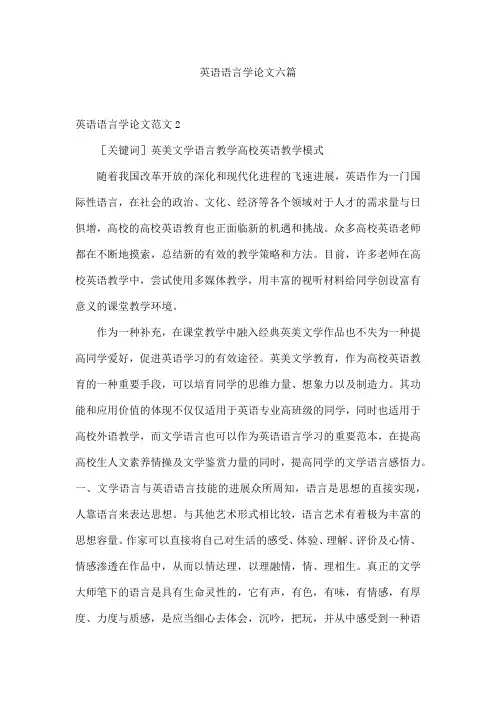
英语语言学论文六篇英语语言学论文范文2[关键词]英美文学语言教学高校英语教学模式随着我国改革开放的深化和现代化进程的飞速进展,英语作为一门国际性语言,在社会的政治、文化、经济等各个领域对于人才的需求量与日俱增,高校的高校英语教育也正面临新的机遇和挑战。
众多高校英语老师都在不断地摸索,总结新的有效的教学策略和方法。
目前,许多老师在高校英语教学中,尝试使用多媒体教学,用丰富的视听材料给同学创设富有意义的课堂教学环境。
作为一种补充,在课堂教学中融入经典英美文学作品也不失为一种提高同学爱好,促进英语学习的有效途径。
英美文学教育,作为高校英语教育的一种重要手段,可以培育同学的思维力量、想象力以及制造力。
其功能和应用价值的体现不仅仅适用于英语专业高班级的同学,同时也适用于高校外语教学,而文学语言也可以作为英语语言学习的重要范本,在提高高校生人文素养情操及文学鉴赏力量的同时,提高同学的文学语言感悟力。
一、文学语言与英语语言技能的进展众所周知,语言是思想的直接实现,人靠语言来表达思想。
与其他艺术形式相比较,语言艺术有着极为丰富的思想容量。
作家可以直接将自己对生活的感受、体验、理解、评价及心情、情感渗透在作品中,从而以情达理,以理融情,情、理相生。
真正的文学大师笔下的语言是具有生命灵性的,它有声,有色,有味,有情感,有厚度、力度与质感,是应当细心去体会,沉吟,把玩,并从中感受到一种语言的趣味性。
因此语言的背后是人的心灵世界。
对文学语言美的敏感与驾驭力量,是提高人的精神境界,使人变得更加美妙的不行或缺的方面。
文学阅读的魅力与意义也就在于此。
目前的高校英语教学,仍旧停留在传统的单纯课文教学,语言点讲解等层面上,课本内容相对陈旧,老师的教学手段也并无创新之处。
其弊端是忽视英语的基本功能即表达功能,也忽视了同学在教学活动中的主体作用,另外还忽视了对同学英语学习爱好的培育,将生硬的课本内容强行“灌输”;至同学脑海中,使整个课堂教学环节缺乏生气,长此以往,高校英语教学将陷入僵局。
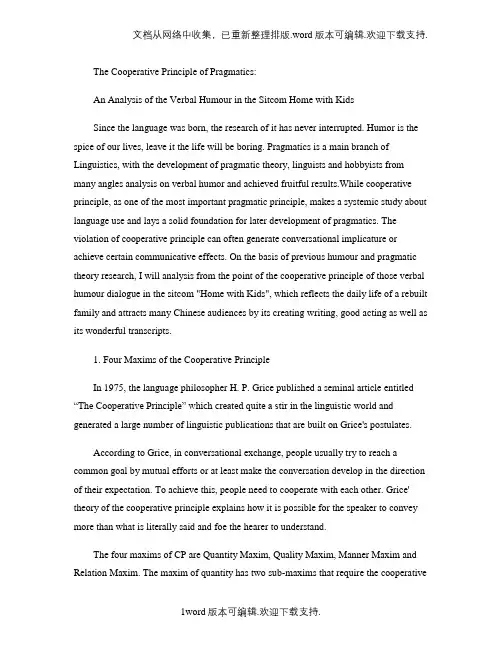
The Cooperative Principle of Pragmatics:An Analysis of the Verbal Humour in the Sitcom Home with KidsSince the language was born, the research of it has never interrupted. Humor is the spice of our lives, leave it the life will be boring. Pragmatics is a main branch of Linguistics, with the development of pragmatic theory, linguists and hobbyists from many angles analysis on verbal humor and achieved fruitful results.While cooperative principle, as one of the most important pragmatic principle, makes a systemic study about language use and lays a solid foundation for later development of pragmatics. The violation of cooperative principle can often generate conversational implicature or achieve certain communicative effects. On the basis of previous humour and pragmatic theory research, I will analysis from the point of the cooperative principle of those verbal humour dialogue in the sitcom "Home with Kids", which reflects the daily life of a rebuilt family and attracts many Chinese audiences by its creating writing, good acting as well as its wonderful transcripts.1. Four Maxims of the Cooperative PrincipleIn 1975, the language philosopher H. P. Grice published a seminal article entitled “The Cooperative Principle” which created quite a stir in the linguis tic world and generated a large number of linguistic publications that are built on Grice's postulates.According to Grice, in conversational exchange, people usually try to reach a common goal by mutual efforts or at least make the conversation develop in the direction of their expectation. To achieve this, people need to cooperate with each other. Grice' theory of the cooperative principle explains how it is possible for the speaker to convey more than what is literally said and foe the hearer to understand.The four maxims of CP are Quantity Maxim, Quality Maxim, Manner Maxim and Relation Maxim. The maxim of quantity has two sub-maxims that require the cooperativespeaker to say as much as but no more than is required for his particular purposes in the talk exchange. The maxim of quality also has two sub-maxims, which demands that the speaker say only what he believes to be true and for which he has sufficient evidence. The maxim of relation urges the speaker to make his contribution relevant to the communication context. The maxim of manner requires the speaker to be methodical and to avoid ambiguity, prolixity, and obscurity. In short, as Grice put it for the cooperative principle, "make yourconversational contribution such as is required,at the stage at which it occurs, by the accepted purpose or direction of the talk exchange in which you are engaged". The cooperative principle is the foundation of pragmatic interpretation of humor, of which the flouting of maxims plays a very important role.2. Floutings of CP Maxims and Humor ProductionIn actual conversation, a participant may deliberately flout CP maxims for some reason or special need. As an important category of non-observance of the conversational maxims, a flout is distinguished by deliberately triggering the hearer's search for an implicature. The speaker employs this way seemingly against the cooperative principle to reinforce the communicative effect. In this way the speaker can make his conversation humorous and thus produce the effect of humor. In fact, flouting of the CP is often seen in Chinese sitcoms. Of course, sitcom writers also deliberately flout the principle in order to achieve humorous effects.2.1 Flouting the Quantity MaximWhen a speaker offers more or less information than is required by the situation with the intention of generating an implicature, he flouts the maxim of quantity. Look at the following example:(1 (In Episode 093, Liu Xing goes to Internet café and Liu Mei keeps asking what he did there.Xing: You'd better not interfere with my business from now on!(以后我的事情你少管 .Mei: What did you say? I don't interfere with your business? Why didn't you say it when I breast-fed you? Why didn't you say it when you were sick? Why didn't you say it when you fell to the ground?Why didn't you say it when you couldn't walk? You don't want me to interfere with you now, because you are grown up and can do whatever you want? (你说什么呢 ? 再说一遍 ! 我少管 ? 你小时候喝奶的时候怎么不说 ? 小时候生病的时候怎么不说呀 ? 摔跟头时候怎么不说呀 ? 学会走路时候怎么不说 ? 这时候让我少管。
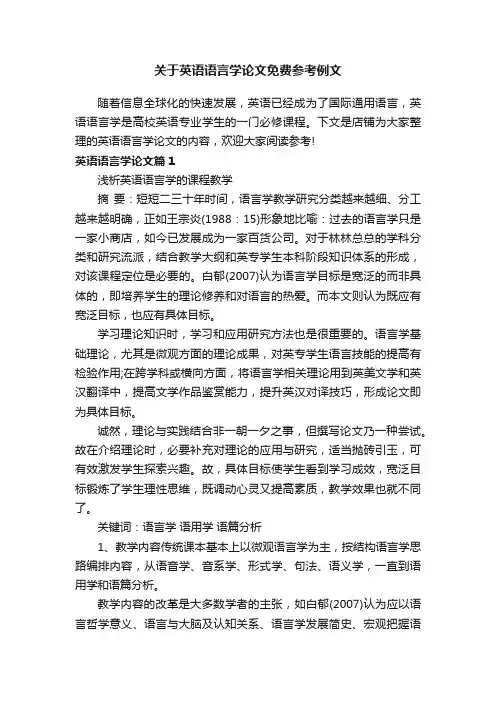
关于英语语言学论文免费参考例文随着信息全球化的快速发展,英语已经成为了国际通用语言,英语语言学是高校英语专业学生的一门必修课程。
下文是店铺为大家整理的英语语言学论文的内容,欢迎大家阅读参考!英语语言学论文篇1浅析英语语言学的课程教学摘要:短短二三十年时间,语言学教学研究分类越来越细、分工越来越明确,正如王宗炎(1988:15)形象地比喻:过去的语言学只是一家小商店,如今已发展成为一家百货公司。
对于林林总总的学科分类和研究流派,结合教学大纲和英专学生本科阶段知识体系的形成,对该课程定位是必要的。
白郁(2007)认为语言学目标是宽泛的而非具体的,即培养学生的理论修养和对语言的热爱。
而本文则认为既应有宽泛目标,也应有具体目标。
学习理论知识时,学习和应用研究方法也是很重要的。
语言学基础理论,尤其是微观方面的理论成果,对英专学生语言技能的提高有检验作用;在跨学科或横向方面,将语言学相关理论用到英美文学和英汉翻译中,提高文学作品鉴赏能力,提升英汉对译技巧,形成论文即为具体目标。
诚然,理论与实践结合非一朝一夕之事,但撰写论文乃一种尝试。
故在介绍理论时,必要补充对理论的应用与研究,适当抛砖引玉,可有效激发学生探索兴趣。
故,具体目标使学生看到学习成效,宽泛目标锻炼了学生理性思维,既调动心灵又提高素质,教学效果也就不同了。
关键词:语言学语用学语篇分析1、教学内容传统课本基本上以微观语言学为主,按结构语言学思路编排内容,从语音学、音系学、形式学、句法、语义学,一直到语用学和语篇分析。
教学内容的改革是大多数学者的主张,如白郁(2007)认为应以语言哲学意义、语言与大脑及认知关系、语言学发展简史、宏观把握语言学真正意义等四方面为重。
还有学者认为增加课外阅读材料以改进教学内容,如王扬(2004)和吴格奇(2005)主张选用有助于学生理解基本理论、概念的材料、辅之以拓宽视野的补充材料。
还有以宏观还是微观语言学内容作为教学重点的争论:“微观”派认为语言内部分支是语言学的基础内容,课时分配比重要大;“宏观”派认为基础部分简单,学生可自学,重点应是宏观介绍;“中间”派是既注重基础又考虑涉猎面。
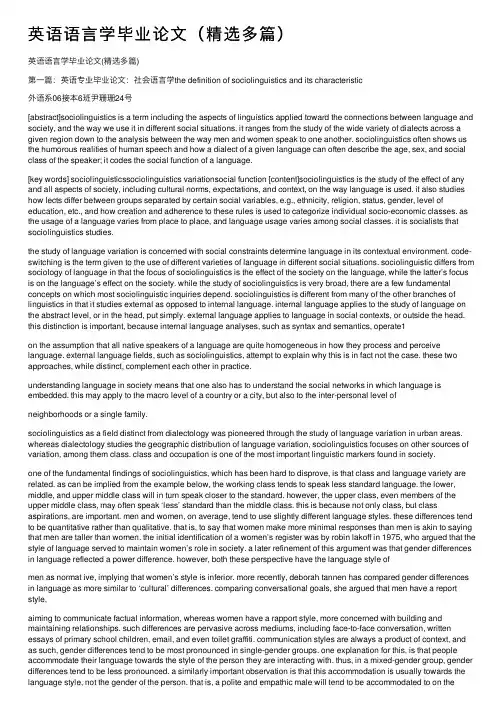
英语语⾔学毕业论⽂(精选多篇)英语语⾔学毕业论⽂(精选多篇)第⼀篇:英语专业毕业论⽂:社会语⾔学the definition of sociolinguistics and its characteristic外语系06接本6班尹珊珊24号[abstract]sociolinguistics is a term including the aspects of linguistics applied toward the connections between language and society, and the way we use it in different social situations. it ranges from the study of the wide variety of dialects across a given region down to the analysis between the way men and women speak to one another. sociolinguistics often shows us the humorous realities of human speech and how a dialect of a given language can often describe the age, sex, and social class of the speaker; it codes the social function of a language.[key words] sociolinguisticssociolinguistics variationsocial function [content]sociolinguistics is the study of the effect of any and all aspects of society, including cultural norms, expectations, and context, on the way language is used. it also studies how lects differ between groups separated by certain social variables, e.g., ethnicity, religion, status, gender, level of education, etc., and how creation and adherence to these rules is used to categorize individual socio-economic classes. as the usage of a language varies from place to place, and language usage varies among social classes. it is socialists that sociolinguistics studies.the study of language variation is concerned with social constraints determine language in its contextual environment. code-switching is the term given to the use of different varieties of language in different social situations. sociolinguistic differs from sociology of language in that the focus of sociolinguistics is the effect of the society on the language, while the latter’s focus is on the language’s effect on the society. while the study of sociolinguistics is very broad, there are a few fundamental concepts on which most sociolinguistic inquiries depend. sociolinguistics is different from many of the other branches of linguistics in that it studies external as opposed to internal language. internal language applies to the study of language on the abstract level, or in the head, put simply. external language applies to language in social contexts, or outside the head. this distinction is important, because internal language analyses, such as syntax and semantics, operate1on the assumption that all native speakers of a language are quite homogeneous in how they process and perceive language. external language fields, such as sociolinguistics, attempt to explain why this is in fact not the case. these two approaches, while distinct, complement each other in practice.understanding language in society means that one also has to understand the social networks in which language is embedded. this may apply to the macro level of a country or a city, but also to the inter-personal level ofneighborhoods or a single family.sociolinguistics as a field distinct from dialectology was pioneered through the study of language variation in urban areas. whereas dialectology studies the geographic distribution of language variation, sociolinguistics focuses on other sources of variation, among them class. class and occupation is one of the most important linguistic markers found in society.one of the fundamental findings of sociolinguistics, which has been hard to disprove, is that class and language variety are related. as can be implied from the example below, the working class tends to speak less standard language. the lower, middle, and upper middle class will in turn speak closer to the standard. however, the upper class, even members of the upper middle class, may often speak ‘less’ standard than the middle class. this is because not only class, but class aspirations, are important. men and women, on average, tend to use slightly different language styles. these differences tend to be quantitative rather than qualitative. that is, to say that women make more minimal responses than men is akin to saying that men are taller than women. the initial identification of a women’s register was by robin lakoff in 1975, who argued that the style of language served to maintain women’s role in society. a later refinement of this argument was that gender differences in language reflected a power difference. however, both these perspective have the language style ofmen as normat ive, implying that women’s style is inferior. more recently, deborah tannen has compared gender differences in language as more similar to ‘cultural’ differences. comparing conversational goals, she argued that men have a report style,aiming to communicate factual information, whereas women have a rapport style, more concerned with building and maintaining relationships. such differences are pervasive across mediums, including face-to-face conversation, written essays of primary school children, email, and even toilet graffiti. communication styles are always a product of context, and as such, gender differences tend to be most pronounced in single-gender groups. one explanation for this, is that people accommodate their language towards the style of the person they are interacting with. thus, in a mixed-gender group, gender differences tend to be less pronounced. a similarly important observation is that this accommodation is usually towards the language style, not the gender of the person. that is, a polite and empathic male will tend to be accommodated to on thebasis of their being polite and empathic, rather than their being male. sociolinguistics has drawn more and more attention since it became an independent discipline in mid 1960s. but scholars from various disciplines look at sociolinguistics from different perspectives, and carry out sociolinguistic study in different ways. this paper tries to understand sociolinguistics in terms of its definitions and the scope of sociolinguisticstudy to point o ut the lack of comprehensiveness in fishman’’s view on the definition of sociolinguistics.参考⽂献:《社会语⾔学概论》戴庆厦主编商务印书馆《社会语⾔学概论》祝畹瑾编著湖南教育出版社.《语⾔学概论》杨信彰⾼等教育出版社第⼆篇:英语语⾔学论⽂题⽬英语语⾔学论⽂题⽬13论国际商务谈判中的语⾔交际技巧33成⼈世界的童话——从⽂体学⾓度解析现今童话再度流⾏的现象49论⽂化差异与英汉商标互译55浅谈英汉句⼦结构差异59诗意的美和喜剧性幽默62试论⼴告英语的语⾔特点65统觉团对英语初学者词汇学习的影响67外语学习中应该重视中介语的作⽤69新闻报道中的转述动词研究73英汉禁忌语、委婉语的对⽐研究74英汉数字习语的对⽐研究76英译汉中词序的变动78英语⼴告的语⾔特征80英语双关语汉译的可译性限度101词义演变的原因与⽅式137从汉语中英语借词的翻译看⽂化交流138从价值观转换看斯佳丽的⾓⾊特征142从礼貌准则看中英⽂化的异同146从习语看英汉民族的⽂化差异149从英语⼈名中看性别歧视157动词过程类型的选择和话语隐性态度的表达161对母语在英语写作中词汇负迁移现象的思考162对严复译作中“信”的质疑167法律英语⽤词特征分析168法律语⾔翻译与法律⽂体177副词ever的句法环境和语义特征180功能语法视⾓下的英语报纸新闻标题的功能183⼴告⼝号语的语⾔特点189国际商务⽂化之对⽐研究204汉语中双关语的翻译213基于概念隐喻的诗歌解读228论⼴告英语中的幽默265论⼴告英语的语⾔特点268论汉英谚语的语⾔特征280论清教理念与美国西进运动282论莎⼠⽐亚⼗四⾏诗中的时间300论英语⼴告中⼏种常⽤修辞格及其汉译310论尤⾦?奥尼尔的表现主义⼿法324名词化的语篇功能330诺曼时期法语对英语词汇的影响339浅谈英语虚拟语⽓的语⽤功能340浅谈英语虚拟语⽓及其语⽤功能345浅析⼆⼗世纪计算机英语词汇的构成特点346浅析汉英动物谚语中的⽂化348浅析英汉语⾔中的性别歧视现象及其根源349浅析英语禁忌语及其发展352浅析英语⽆标志被动句356浅议译者能⼒359认知语⾔学⾓度下“within” 的空间隐喻意义365商标英语汉译的原则和⽅法384体育新闻英语⽂体研究375社会语⾔学视野中的⽹络语⾔418新闻英语中的语法特点研究423颜⾊词在英汉互译中的不对应性425移就的审美价值和⽣成基础426以认知为基础的颜⾊隐喻研究428隐喻认知功能研究的新视⾓429隐喻与⼀词多义的关系438英汉被动句对⽐研究439英汉宾语类型差异的认知原因。
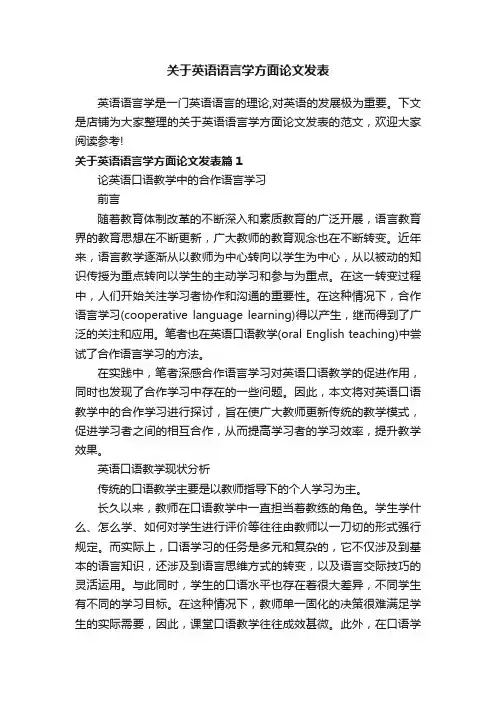
关于英语语言学方面论文发表英语语言学是一门英语语言的理论,对英语的发展极为重要。
下文是店铺为大家整理的关于英语语言学方面论文发表的范文,欢迎大家阅读参考!关于英语语言学方面论文发表篇1论英语口语教学中的合作语言学习前言随着教育体制改革的不断深入和素质教育的广泛开展,语言教育界的教育思想在不断更新,广大教师的教育观念也在不断转变。
近年来,语言教学逐渐从以教师为中心转向以学生为中心,从以被动的知识传授为重点转向以学生的主动学习和参与为重点。
在这一转变过程中,人们开始关注学习者协作和沟通的重要性。
在这种情况下,合作语言学习(cooperative language learning)得以产生,继而得到了广泛的关注和应用。
笔者也在英语口语教学(oral English teaching)中尝试了合作语言学习的方法。
在实践中,笔者深感合作语言学习对英语口语教学的促进作用,同时也发现了合作学习中存在的一些问题。
因此,本文将对英语口语教学中的合作学习进行探讨,旨在使广大教师更新传统的教学模式,促进学习者之间的相互合作,从而提高学习者的学习效率,提升教学效果。
英语口语教学现状分析传统的口语教学主要是以教师指导下的个人学习为主。
长久以来,教师在口语教学中一直担当着教练的角色。
学生学什么、怎么学、如何对学生进行评价等往往由教师以一刀切的形式强行规定。
而实际上,口语学习的任务是多元和复杂的,它不仅涉及到基本的语言知识,还涉及到语言思维方式的转变,以及语言交际技巧的灵活运用。
与此同时,学生的口语水平也存在着很大差异,不同学生有不同的学习目标。
在这种情况下,教师单一固化的决策很难满足学生的实际需要,因此,课堂口语教学往往成效甚微。
此外,在口语学习中,教师还一直发挥着模范示例的作用。
教师的语音(pronunciation)、语调(intonation)、语气(tone)、措辞(expression)、语言习惯(language habit)等都是学生模仿和学习的对象,因此,实际的教学中我们经常会看到一个教师的学生在口语使用上有惊人的雷同和类似,而这种千人一律的口语并不是我们口语教学的初衷。
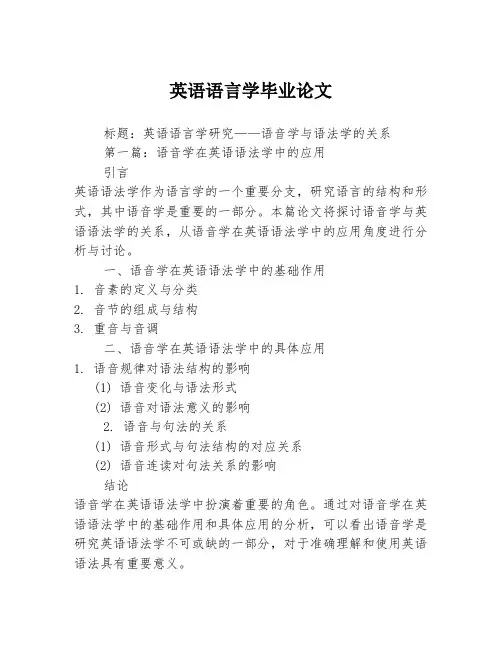
英语语言学毕业论文标题:英语语言学研究——语音学与语法学的关系第一篇:语音学在英语语法学中的应用引言英语语法学作为语言学的一个重要分支,研究语言的结构和形式,其中语音学是重要的一部分。
本篇论文将探讨语音学与英语语法学的关系,从语音学在英语语法学中的应用角度进行分析与讨论。
一、语音学在英语语法学中的基础作用1. 音素的定义与分类2. 音节的组成与结构3. 重音与音调二、语音学在英语语法学中的具体应用1. 语音规律对语法结构的影响(1) 语音变化与语法形式(2) 语音对语法意义的影响2. 语音与句法的关系(1) 语音形式与句法结构的对应关系(2) 语音连读对句法关系的影响结论语音学在英语语法学中扮演着重要的角色。
通过对语音学在英语语法学中的基础作用和具体应用的分析,可以看出语音学是研究英语语法学不可或缺的一部分,对于准确理解和使用英语语法具有重要意义。
第二篇:语法学在英语语音学中的应用引言英语语音学作为语言学的一个重要分支,研究语音的产生、传播和接收,其中语法学是重要的一部分。
本篇论文将探讨语法学与英语语音学的关系,从语法学在英语语音学中的应用角度进行分析与讨论。
一、语法学在英语语音学中的基础作用1. 语音规则与语法关系2. 重读与语法意义关联3. 语法结构对语音形式的影响二、语法学在英语语音学中的具体应用1. 语法规则对语音的影响(1) 语法变化与语音形式(2) 语法对语音意义的影响2. 语法与韵律的关系(1) 语法结构对韵律的影响(2) 语法形式与语音调的关联结论语法学在英语语音学中发挥着重要的作用。
通过对语法学在英语语音学中的基础作用和具体应用的分析,可以看出语法学是研究英语语音学不可或缺的一部分,对于深入理解和研究英语语音规律具有重要意义。
参考文献:1. Yule, G. (2010). The Study of Language (4th ed.). Cambridge University Press.2. Fromkin, V., Rodman, R., & Hyams, N. (2017). An Introduction to Language (11th ed.). Nelson Education.3. Ladefoged, P., & Johnson, K. (2010). A Course in Phonetics (6th ed.). Wadsworth Publishing.。
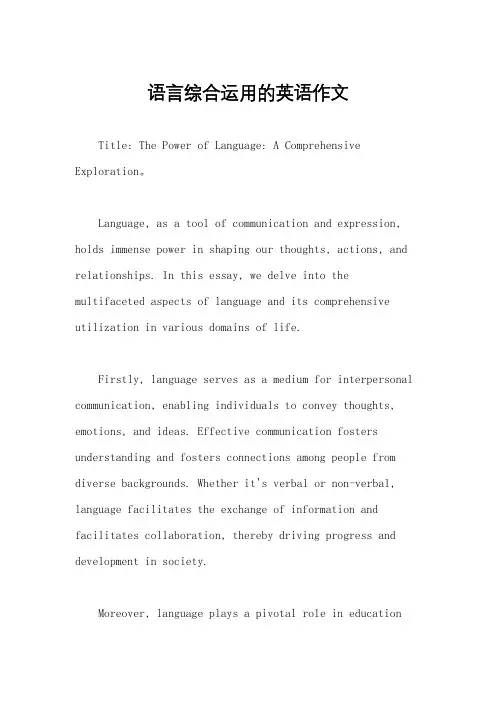
语言综合运用的英语作文Title: The Power of Language: A Comprehensive Exploration。
Language, as a tool of communication and expression, holds immense power in shaping our thoughts, actions, and relationships. In this essay, we delve into the multifaceted aspects of language and its comprehensive utilization in various domains of life.Firstly, language serves as a medium for interpersonal communication, enabling individuals to convey thoughts, emotions, and ideas. Effective communication fosters understanding and fosters connections among people from diverse backgrounds. Whether it's verbal or non-verbal, language facilitates the exchange of information and facilitates collaboration, thereby driving progress and development in society.Moreover, language plays a pivotal role in educationand intellectual growth. Through language, we acquire knowledge, learn new concepts, and engage in critical thinking. From reading literature to solving mathematical equations, language proficiency is integral to academic success and lifelong learning. Additionally, mastering multiple languages not only enhances cognitive abilities but also broadens cultural horizons, promoting tolerance and global citizenship.Furthermore, language is a tool for cultural preservation and identity formation. Dialects, idioms, and linguistic nuances encapsulate the rich tapestry of human heritage, reflecting the customs, beliefs, and traditions of different communities. By preserving indigenous languages and dialects, we safeguard cultural diversity and promote inclusivity, ensuring that every voice is heard and valued in the global discourse.In addition to its social and cultural dimensions, language exerts significant influence in the realm of politics and diplomacy. Diplomatic negotiations, international treaties, and intergovernmentalcommunications hinge upon linguistic precision and diplomatic tact. Mastery of diplomatic language and negotiation strategies is essential for diplomats and policymakers to navigate complex geopolitical landscapes and resolve conflicts amicably.Moreover, language serves as a tool for persuasion and rhetoric in the domains of advertising, marketing, and media. Advertisements leverage persuasive language techniques to influence consumer behavior and shape brand perceptions. Likewise, media outlets utilize language to frame narratives, sway public opinion, and drive social change. The power of language in shaping public discourse underscores the ethical responsibility of communicators to uphold truthfulness, transparency, and integrity in their messaging.Beyond its utilitarian functions, language also serves as a vehicle for artistic expression and creative endeavor. Literature, poetry, music, and theater are manifestations of human creativity articulated through language. Writers, poets, and artists harness the evocative power of words toevoke emotions, provoke thoughts, and inspire social change. Through storytelling and artistic expression, language transcends barriers of time and space, resonating with audiences across generations and cultures.In conclusion, language is a dynamic and multifaceted phenomenon that permeates every aspect of human existence. From interpersonal communication to cultural preservation, from politics to art, language shapes our perceptions, influences our interactions, and defines our collective identity as a global community. Recognizing the transformative power of language, we must strive to wieldit responsibly, ethically, and inclusively, fosteringmutual understanding, empathy, and collaboration in an increasingly interconnected world.。
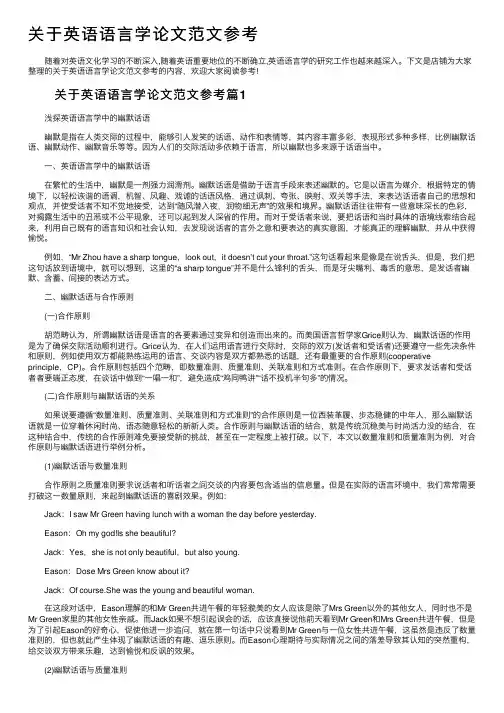
关于英语语⾔学论⽂范⽂参考 随着对英语⽂化学习的不断深⼊,随着英语重要地位的不断确⽴,英语语⾔学的研究⼯作也越来越深⼊。
下⽂是店铺为⼤家整理的关于英语语⾔学论⽂范⽂参考的内容,欢迎⼤家阅读参考! 关于英语语⾔学论⽂范⽂参考篇1 浅探英语语⾔学中的幽默话语 幽默是指在⼈类交际的过程中,能够引⼈发笑的话语、动作和表情等,其内容丰富多彩,表现形式多种多样,⽐例幽默话语、幽默动作、幽默⾳乐等等。
因为⼈们的交际活动多依赖于语⾔,所以幽默也多来源于话语当中。
⼀、英语语⾔学中的幽默话语 在繁忙的⽣活中,幽默是⼀剂强⼒润滑剂。
幽默话语是借助于语⾔⼿段来表述幽默的。
它是以语⾔为媒介,根据特定的情境下,以轻松诙谐的语调,机智、风趣、戏谑的话语风格,通过讽刺、夸张、映射、双关等⼿法,来表达话语者⾃⼰的思想和观点,并使受话者不知不觉地接受,达到“随风潜⼊夜,润物细⽆声”的效果和境界。
幽默话语往往带有⼀些意味深长的⾊彩,对揭露⽣活中的丑恶或不公平现象,还可以起到发⼈深省的作⽤。
⽽对于受话者来说,要把话语和当时具体的语境线索结合起来,利⽤⾃⼰既有的语⾔知识和社会认知,去发现说话者的⾔外之意和要表达的真实意图,才能真正的理解幽默,并从中获得愉悦。
例如,“Mr Zhou have a sharp tongue,look out,it doesn’t cut your throat.”这句话看起来是像是在说⾆头,但是,我们把这句话放到语境中,就可以想到,这⾥的“a sharp tongue”并不是什么锋利的⾆头,⽽是⽛尖嘴利、毒⾆的意思,是发话者幽默、含蓄、间接的表达⽅式。
⼆、幽默话语与合作原则 (⼀)合作原则 胡范畴认为,所谓幽默话语是语⾔的各要素通过变异和创造⽽出来的。
⽽美国语⾔哲学家Grice则认为,幽默话语的作⽤是为了确保交际活动顺利进⾏。
Grice认为,在⼈们运⽤语⾔进⾏交际时,交际的双⽅(发话者和受话者)还要遵守⼀些先决条件和原则,例如使⽤双⽅都能熟练运⽤的语⾔、交谈内容是双⽅都熟悉的话题,还有最重要的合作原则(cooperative principle,CP)。
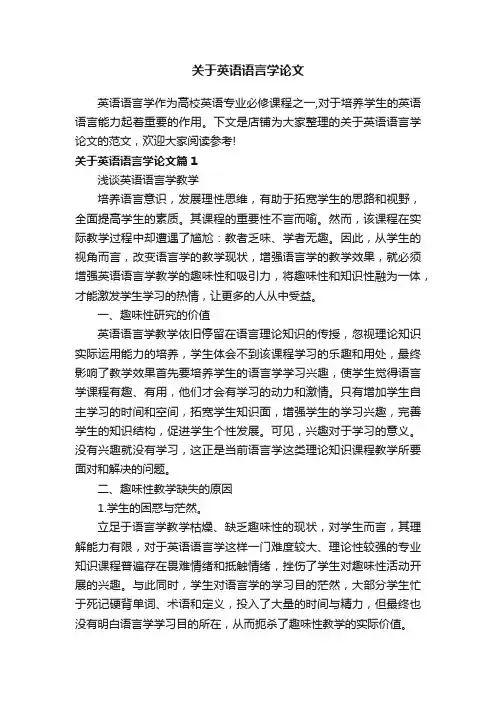
关于英语语言学论文英语语言学作为高校英语专业必修课程之一,对于培养学生的英语语言能力起着重要的作用。
下文是店铺为大家整理的关于英语语言学论文的范文,欢迎大家阅读参考!关于英语语言学论文篇1浅谈英语语言学教学培养语言意识,发展理性思维,有助于拓宽学生的思路和视野,全面提高学生的素质。
其课程的重要性不言而喻。
然而,该课程在实际教学过程中却遭遇了尴尬:教者乏味、学者无趣。
因此,从学生的视角而言,改变语言学的教学现状,增强语言学的教学效果,就必须增强英语语言学教学的趣味性和吸引力,将趣味性和知识性融为一体,才能激发学生学习的热情,让更多的人从中受益。
一、趣味性研究的价值英语语言学教学依旧停留在语言理论知识的传授,忽视理论知识实际运用能力的培养,学生体会不到该课程学习的乐趣和用处,最终影响了教学效果首先要培养学生的语言学学习兴趣,使学生觉得语言学课程有趣、有用,他们才会有学习的动力和激情。
只有增加学生自主学习的时间和空间,拓宽学生知识面,增强学生的学习兴趣,完善学生的知识结构,促进学生个性发展。
可见,兴趣对于学习的意义。
没有兴趣就没有学习,这正是当前语言学这类理论知识课程教学所要面对和解决的问题。
二、趣味性教学缺失的原因1.学生的困惑与茫然。
立足于语言学教学枯燥、缺乏趣味性的现状,对学生而言,其理解能力有限,对于英语语言学这样一门难度较大、理论性较强的专业知识课程普遍存在畏难情绪和抵触情绪,挫伤了学生对趣味性活动开展的兴趣。
与此同时,学生对语言学的学习目的茫然,大部分学生忙于死记硬背单词、术语和定义,投入了大量的时间与精力,但最终也没有明白语言学学习目的所在,从而扼杀了趣味性教学的实际价值。
2.教师的自我中心主义。
语言学教学无疑成了教师死板地给对学生灌输语言学术语的过程,学生丧失了发现问题、独立思考、平等交流的机会,其能力的培养自然无从谈起。
理论知识是研究人员和学者研究的成果和理论,包括专业知识、教育理论知识、关于人类发展的知识、指导课堂组织的理论知识、教学法知识、评价理论知识、社会文化知识,等等。
英语语言学方面论文英语作为一种国际化的语言,在信息化、全球化日益发展的今天,其作用越来越重要。
下文是店铺为大家整理的关于英语语言学方面论文的范文,欢迎大家阅读参考!英语语言学方面论文篇1浅探新时代和谐英语语言学课堂的构建【摘要】探索一条有效的语言学教学途径一直是大学英语教育者关注的问题,本文从和谐的角度探讨英语语言学和谐课堂的构建。
分析什么是和谐课堂,进而利用和谐教学、和谐环境等理论方法指导语言学教学的实际,达到构建英语语言学和谐课堂的效果。
【关键词】英语语言学语言学课堂和谐课堂的构建良好的和谐的课堂气氛能激活学生的脑细胞,激发他们的学习兴趣,开发他们的思维潜能,更好地促进他们接受新知识,掌握新技能。
如何创造和谐的课堂气氛,有效地促进教学,是每个英语教学者都必然关注的问题。
美国心理学家罗杰斯认为:“成功的教学依赖于一种真诚的理解和信任的师生关系,依赖于一种和谐安全的课堂气氛。
”由此可见,一个成功的课堂与和谐安全的课堂气氛息息相关。
英语专业的学生在掌握了听说读写这些基本技能的基础上,需要进一步比较全面、比较系统地了解现代语言学这一领域的研究成果,以及一些最主要、最有影响的语言理论和原则,从而加深对人类语言这一人类社会普遍现象的理性认识,并具备一定的运用语言学理论解释语言现象、解决具体语言问题的能力,提高自身的语言修养和学习语言的能力。
一、英语语言学课程的特点课程的教学任务和目的是向学生讲授英语语言的属性、功能、起源和内部层次,掌握英语语言学基本特征和主要分支的基本概念,了解语言在时空中的变异及其与社会、文化、语境、思维等外部因素的关系,同时了解部分主要语言学流派。
英语语言学的教学内容宽泛,不易深细,主要包括英语语言和英语语言学领域中各分支的基础理论,如语音学、音系学、形态学、句法学、语义学、语用学等基本内容,也包括了语言的变异及其与外部因素的关系。
二、英语语言学的授课对象英语语言学教程的授课对象是学习英语的高等院校学生,因此在讲解过程中大部分采用了英语。
语言学作用的英语作文The Powerful Impact of Language: Exploring the Realm of LinguisticsLanguage is the foundation upon which human civilization has been built. It is the medium through which we communicate, express our thoughts, and connect with one another. The study of language, known as linguistics, delves into the intricate workings of this essential tool, revealing its profound impact on our lives. From the nuances of phonology to the complexities of syntax, the field of linguistics sheds light on the remarkable capabilities of human language and its far-reaching implications.At the core of linguistics lies the understanding of how language is acquired, processed, and utilized. The study of language acquisition explores the remarkable ability of children to effortlessly pick up and master their native tongue, a process that has captivated linguists and developmental psychologists alike. The innate capacity of the human brain to acquire language, as posited by renowned linguist Noam Chomsky, has led to groundbreaking insights into the underlying mechanisms that govern this phenomenon.Beyond the realm of language acquisition, linguistics also examinesthe structural components of language. Phonology, the study of sound patterns, delves into the intricate workings of speech production and perception, shedding light on the ways in which the human vocal apparatus and auditory system interact to create and decode the building blocks of language. Morphology, the study of word formation, explores the rules and patterns that govern the construction of words, while syntax investigates the principles that underlie the organization of words into meaningful sentences.The field of semantics, on the other hand, focuses on the meaning of language, exploring the ways in which words and phrases convey conceptual and contextual significance. This area of linguistics is particularly fascinating, as it unveils the complex interplay between language and cognition, revealing how our understanding of the world is shaped and expressed through the medium of language.Sociolinguistics, a subfield of linguistics, examines the relationship between language and society, exploring the ways in which language use is influenced by social factors such as age, gender, ethnicity, and social status. This area of study has significant implications for our understanding of language variation, language change, and the role of language in shaping cultural identity and social dynamics.The study of language also has profound implications for our understanding of the human mind and cognitive processes.Psycholinguistics, the intersection of linguistics and psychology, investigates the cognitive mechanisms underlying language processing, including how we comprehend, produce, and store linguistic information. This field has contributed to our understanding of the neural underpinnings of language, as well as the ways in which language interacts with other cognitive functions, such as memory, attention, and decision-making.The practical applications of linguistics are far-reaching and diverse. In the field of education, linguists play a crucial role in developing effective language-learning strategies, designing curriculum, and addressing issues of language diversity and inclusion. In the realm of technology, linguists contribute to the development of natural language processing algorithms, machine translation systems, and speech recognition software, enabling seamless communication between humans and machines.Moreover, the study of linguistics has important implications for our understanding of human evolution and the origins of language. Evolutionary linguists explore the emergence and development of language as a uniquely human trait, shedding light on the cognitive and social factors that may have contributed to its evolution. This research has the potential to deepen our understanding of the human condition and the remarkable capacity of our species to create and utilize language.In conclusion, the field of linguistics is a vast and multifaceted discipline that offers a profound understanding of the nature of language and its impact on human experience. From the intricacies of language acquisition to the sociocultural implications of linguistic variation, the study of linguistics has the power to transform our perspectives on communication, cognition, and the very essence of what it means to be human. As we continue to explore the vast and captivating realm of linguistics, we uncover new insights that have the potential to shape our understanding of the world and our place within it.。
英语语言学方面论文(2)英语语言学方面论文篇3浅析语言学习中的英汉对比论文关键词:语言学习母语正迁移母语负迁移论文摘要:在二语学习中,学习者的母语会对二语习得产生独特的影响,因此在语言的学习中,要针对其特点,采取对应的方法。
英汉对比教学和学习能有效地降低语言学习中的母语负迁移,更好地发挥母语的正迁移作用。
1 引言二语习得过程中,母语会不可避免地对学习者产生一定的影响。
母语和二语之间的相似之处会促进语言的学习,此现象为母语正迁移;而不同之处将阻碍语言的学习,此现象被称之为母语负迁移。
学习者要有意识地发挥其有利的影响,降低其不利影响。
因此英汉对比研究对二语习得是非常必要的。
2 英汉对比学习的理论依据在二语习得过程中,母语会产生迁移作用,这是被语言学家所证实的事实。
Odlin(2001)这样定义语言迁移,它是一种跨语言的影响,这种影响是由学习者先前习得的语言和目标语之间的相似和差异引起。
语言之间的相似之处有助于二语的习得,这种影响称之为正迁移,而语言之间的差异会阻碍二语的习得,称之为负迁移。
在二语习得过程中,先前习得的语言,一般是母语,已经有了完善的知识结构和牢固的基础,这一特点给二语习得带来的既有积极的作用,同时也会产生负面的影响。
如何发挥其积极作用,减少负面影响是语言学习者有效提高语言学习效率的重要方面。
因此英汉不同之处的对比就变得尤为重要。
3 英汉对比的方面3.1 本体对比3.1.1 大小写方面在汉语中,我们不用考虑汉字的大小写,因为汉字不存在大小写的区别。
而英语的字母则不同,有大小写之分。
以汉语为母语的学习者,由于大小写概念不强,母语的不区分大小写的印象又很深,因此很容易在此方面出错。
英语中一个句子的首字母是必须要大写的,还有一些专有名词,如地名,人名,书名等。
3.1.2 标点符号英汉语在标点上有些是不同的,如句号的写法。
英语是一个实心的圆点,而汉语是一个圆圈。
汉语中有书名号,英语中用引号,或斜体不加标点。
英语语言学论文(优秀9篇)《浅析美国英语与英国英语的区别及应用》摘要:标准现代英式英语和美式英语,虽然两者互相理解没有很多实质性的差异,但对两者的各方面进行一个大概的比较,还是有很多细微的差别的。
关键词:美国英语;英国英语;分析对比;区别及应用在全球一体化的背景下,英语已成为世界通用语言,在社会生活、交往或交流中都扮演着重要角色。
近年,美式英语风靡全球,尽管美式英语和英式英语都是英语,但是区别甚多。
相对来说美式英语便捷实用,英式英语较为复杂。
英式英语保守、严谨,美国人说英语则是另一种姿态,崇尚可见即可读。
1.两种语言在历史演变、地域文化、社会地位层面的区别。
英语是全世界几千种语言的其中一种,也是印欧语系一百多种语言之一、英国英语距今已有1500的历史了。
而美国英语是在英国英语的基础上发展而来的。
英国和美国在政治、经济、文化等方面的不断发展,造就了它们各自不同的语言特征。
美式英语起源于18世纪70年代,美国的独立战争爆发时,战乱的特殊原因导致绝大多数美国人来自欧洲移民,尤其以英格兰人为主,大多讲英国英语。
近几十年来,由于美国的贸易、军事、科技、国际地位等方面远远超过英国,再加上美国电影风靡全球,促使美国本土的俚语很多已经渗透到了口语之中。
很多因素导致美式英语成为强势语言。
2.发音方面存在的不同。
英语和美语的发音最具代表性的区别是对er的发音的不同。
英语中,短音的er是的浑元音,但长音的er是个拉长了的浑元音,听起来是一个介于“俄”和“啊”的声音。
而美语中,er听起来怎么都是个“儿”音。
ar:除了轻读短音(如singular)和者后连元音(如clarity),英语的ar全部清一色的长音[a:],而美语中,是“阿尔”。
英语和美语的辅音基本是一致的,但在使用习惯上也有些差别。
如词组clear animosity,英语会读成clear,animosity,而美语会读成clear—ranimosity。
另一个比较明显的区别是d和t。
期末论文题目:Analysis on Grammar-Translation Method 所在学院:外国语学院专业:学科教学英语学号:2016281020066作者姓名:谭立力任课教师:汪火焰2017年1 月15 日OUTLINEAbstractKey wordsI. Brief Introduction on Grammar-Translation MethodII. The Advantages of Grammar-Translation MethodIII. The Definition of Grammar and the Relationship Between Grammatical Competence and Communicative Competence.IV. The Revaluation of Grammar-Translation MethodV. ConclusionBibliography中文标题、摘要、关键词Analysis on Grammar-Translation MethodAuthor: Tan Lili Number:2016281020066 Course Name: Applied Linguistics Abstract: Grammar-Translation Method was the major teaching method of foreign language teaching in China. However, it has been impacted and challenged by the emergence of teaching approaches, such as Communicative Language Teaching, Natural Approach and Audio-Lingual method. This paper introduces the teaching status of grammar teaching and discusses its necessity and possibility from three aspects: the nature of grammar, the relationship between grammatical competence and communicative competence, the disadvantages of traditional grammar teaching and its development trend.Key Words: grammar-translation method; advantages and disadvantagesI. Brief Introduction on Grammar-Translation MethodGrammar-Translation Method, which developed more than 1,000 years ago and thrived in 1940s, is the oldest of all language teaching methods. Later, the development of linguistics and psychology formed a theoretical and scientific foundation for Grammar-Translation Method, making it the main method of language teaching and learning until 1960s. Before 1970s, China had cultivated, mainly through Grammar-Translation Method, a large group of English workers and technical personnel with a good command of English. During the Middle Ages, this method was adopted to help people to read the literature written in Latin. In the 18th and 19th century, people used it to teach English and French, thus forming a complete teaching system. In the beginning, people learned language to read and translate Greek and Latin books. It was therefore necessary and effective to carry out teaching with the help of mother tongue and learn these two languages by translation. It conforms, to a large degree, to the objective law under which people understand and learn a foreign language, and enables learners to grasp its grammar system. The study of linguistics also provides the theoretical basis for Grammar-Translation Method. Linguistics refers to the study of language in general and of particular languages, their structure, grammar, and history, therefore providing scientific methods for language teaching. In the 18th century, the study and classification of vocabulary by linguists was of great importance to the development of this method. It is these grammatical terms and division of words that we have always relied on to analyze and explain the text. Linguists also believe that learners should master a foreign languagethrough studying written language, which defines the corresponding categories for the content of this method. Grammar is regarded as an adhesive, through which language learners can express their thought and then master it. As a result, it is seen as the core content of language teaching. Besides, in language learning and teaching, psychology pays more attention to language learners and users. According to Chomsky’s generativism, mankind has an innate ability to form certain concepts, and concept formation is a prerequisite for human’s acquisition of the meanings of words. Generativism is, therefore, in favor of the application of Grammar-Translation Method in language teaching. We can say that its appearance benefits from the linguists’ knowledge of language and the social needs at that time. The principal characteristics of this method were these:1.The purpose of foreign language study is to learn a language in order to read its literature. It stresses students’mental discipline and intellectual development that result from foreign-language study. Students are required to improve their reading skill by reading original work.2.Reading and writing are the major focus; little or no systematic attention is paid to speaking or listening.3.Grammar is taught deductively; and the sentence is the basic unit of teaching and language practice; accuracy is emphasized.People gradually found out the disadvantages of this method after the Second World War, during which there was a huge demand for people who can speak foreign language, students trained by this method cannot meet the needs of the times, generative linguistics became the mainstream of linguistic theory by replacing structural linguistics, and the emergence of cognitivism in psychology led to considerable development in people’s cognitive ability.Communicative Approach and Natural Method dominated linguistics after 1970s, with Grammar-Translation Method faced with severe challenge and almost being abandoned. These theories held that language teaching requires no explanation and language study is not a process of reasoning but a result of people’s inner natural ability under certain circumstance, that language study involves practical conversation. According to Communicative Approach based on the theory of functional linguistics, the purpose of language teaching is to cultivate students’ communicative competence rather than to merelyteach grammar and vocabulary. According to Audio-Lingual Method based on the theory of structural linguistics, learners do not need to understand grammatical rules, for language study is a process of forming habits and the study of sentence structures. It focuses on accuracy through drill and practice in the basic structures and sentence patterns of the target language. Natural Method rejects the formal grammatical organization of language as a prerequisite to teaching and that a focus on comprehension and meaningful communication as well as the provision of the right kinds of comprehensible input provide the necessary and sufficient conditions for successful classroom second and foreign language acquisition . It holds with Newmark and Reibel that “an adult can effectively be taught by grammatically unordered materials”.Influenced by the language teaching pattern of former Soviet union in 1950s and 1960s, China has adopted Grammar-Translation Method as its main teaching method until the early 1980. With the deepening of Chian’s reform and opening up, there existed many foreign linguistic theories and teaching methods and an increasing demand for improving students’ communicative competence. As a result, Grammar-Translation Method gradually dropped out of its mainstream position in language teaching. In various English textbooks published over the past few years, the proportion of grammar is decreasing year by year. In addition, grammar only accounts for ten per cent in all kinds of English examinations. It seems that grammatical competence is opposed to communicative competence, and that grammar teaching has become a dispensable part in language teaching and even become an obstacle to the development of students’ communicative competence.II. The Advantages of Grammar-Translation Method1.It focuses on grammar teaching, combined with vocabulary analysis and abundant translation practice, to train students’ reading and translation ability. The grammar analysis is made in order of difficulty, which well reflects the essential function of language acquisition. Let’s take skill-learning model as an example. Skill-learning-model, from the angel of behaviorism and cognitive development, emphasizes that learners should use exercises to achieve the anticipated purpose, mastering a language. The acquisition of a certain skill entails the integration of skill training of its parts, which is decided by the order in which we use langue. That is to say, the more information---grammar, vocabulary,and syntactic structures---- a language learner gets at the preliminary stage of learning, the more initiative he will have to achieve his higher aim. We can therefore say that it is an effective way to learn a second language through the study of grammar and vocabulary.2.From the perspective of teaching content, it requires students to grasp grammatical rules, vocabulary and sentence structures through a considerable amount of translation practice. This instruction form embodies the student-centered class teaching model in which students, by utilizing the grammatical rules their teachers taught, conduct translation and bilingual conversation so as to be clear about the differences and similarities between their mother tongue and target language and strengthen their understanding of it.3.The characteristics of this method also puts forward a high request to the teachers’and students’language ability. First, only when teachers have a better understanding of both mother tongue and target language , can they impart to their students grammatical knowledge and language structural system and make a judgment about their translation. Second, only when students memorize and recite grammatical rules, can they guarantee the quality of language output. In this way, both students and teachers study and memorize grammatical rules, and grasp the target language through lots of translation exercise.Ⅲ. The Definition of Grammar and the Relationship Between Grammatical Competence and Communicative Competence.In linguistics, grammar is the set of structural rules governing the composition of clauses, phrases, and words in any given natural language. The term refers also to the study of such rules, and this field includes morphology, syntax and phonology, often complemented by phonetics, semantics, and pragmatics. There are several instances. According to Longman Dictionary of Contemporary English written by Paul Procter, grammar refers to the rules by which words change their forms and are combined into sentences. In Crystal’s A First Dictionary of Linguistics and Phonetics, grammar refers to the way words and their component parts, combine to form sentences. These two definitions are limited, but they tell us that grammar is indispensable to correct sentence making. Bowen pointed out that grammar refers to the rules by which we combine meaningful words and phrases into sentences for the communication and the understanding of information. Bowen’s explanation is more precise. Using grammar to make sentencescannot be restricted to its forms and separated from certain meanings, for a sentence , cut off from practical environment, will not produce any meaning. Some scientists, however, enlarge the definition of grammar. Gribbin, for instance, divides grammar into three parts: the unconscious knowledge of language, the conscious knowledge of language, and language rules and usage.There is no doubt that the ultimate purpose of language teaching is to cultivate students’ability to put what he has learned into practical communication, namely, communicative competence. Then the question we should be specific about is whether grammar teaching is opposed to the cultivation of communicative competence. Linguistic competence consists generally of two parts: language knowledge ( pronunciation, vocabulary, and sentence ) and language ability ( listening, speaking, reading, and writing ), of which grammatical competence is the most important part. Communicative competence refers to the ability to achieve a certain communicative aim by a combination of language and non-language ( gestures and facial expressions ) approaches. It generally includes sociolinguistic competence, strategic competence and discourse competence. Language learning should follow three principles: grammatical principle, communicative principle and cultural principle. As linguistic competence is an important condition for the development of communicative competence, and grammatical competence is an important part of linguistic competence, it can be seen that grammatical competence is the most important part of communicative competence. Once grammar teaching is conducted in an appropriate way, it will act as a catalyst for the improvement of communicative competence. And poor grammatical competence will absolutely have a negative impact on the cultivation of communicative competence.We can draw a conclusion from the above discussion that they are not opposed but complementary to each other. What Grammar-Translation Method emphasizes is rational knowledge and rules, grammar, translation and contrast, mother tongue, and language knowledge, without paying much attention to language skills. Communicative Method, taking linguistic function as the key link, centers on pragmatic communication rather than grammar. That is to say, “Fluency is superior to correctness” and “Teaching language rather than teaching knowledge about language”. Grammar-Translation Method can make up for the deficiency of Communicative Method and Audio-Lingual Method in training learners’reading and grammar competence. Communicative Method can in turn remedy the defect of Grammar-Translation Method in practical use. In the middle and later periods of language learning, students, equipped with a certain amount of language knowledge, can reinforce what they have learned and improve their ability in using the language with the help of Communicative Method. However, it does not mean that Grammar-Translation Method should be discarded, since it still plays an essential role in the analysis of long and difficult sentences.IV. The Revaluation of Grammar-Translation MethodIt is undeniable that there are lots of defects in traditional grammar teaching. Without modification and improvement, it would be hard to adapt to the need of our age and to be revitalized. Grammar-Translation Method, with its undiversified teaching means and process, overemphasizes translation exercise and ignores the training of speaking and listening. The analysis of language materials without certain discourse makes the students only focus on the rational analysis of syntax and `impedes the development of students’listening and speaking skill. What students have learned is merely the boring concepts and rules. As they do not have enough opportunity to be exposed to various language forms, these rules and concepts acquired can hardly turn into unconscious knowledge and skill and thus practical communication is beset with difficulties. That is the main reason why at present our country commonly exists the problem of dumb English in foreign language teaching.Despite the deficiencies in traditional language teaching, it does not mean that grammar teaching is unimportant. On the contrary, grammar has always been and will undoubtedly be an important part of language learning.Grammar-Translation Method is the basis of various teaching methods. As it is has been around for a long time, it will inevitably be criticized when there appears other new teaching approaches and methods. Grammar translation emphasizes the study of basic language knowledge. Only by mastering a certain amount of language knowledge and rules, can we carry out imitation training and then develop the ability in using language. Translation plays an important role in language teaching. First, translation can help learners make clear the structure and system of their mother tongue and target language, revealing the corresponding relationship between their forms; Second, in the process of comparingtwo languages, translation can enable us to discover their difference. Language is systematic, and its systematicness is to a large degree reflected in its grammatical structures. Grammar and vocabulary are the sources of communication. Without a deep understanding of the words, and without a fine grasp of grammar rules, the cultivation of communicative competence would become water without source.Grammar-Translation method is an effective way to achieve other teaching methods. It can effectively resolve the difficulties in language teaching, help students accurately grasp the characteristics and differences of two languages. As the famous linguist F. G. French once said, grammatical points should be explained in native language. It is therefore useful to compare English grammatical points with those of Chinese. He added that it would be difficult to explain some words clearly without the help of translation. Grammar -Translation method also helps to improve students’ interest in learning English, enhance their learning motivation, and to a certain degree reduce their learning anxiety and stress. The epiphany about the subtle differences between different languages will enable students to produce a strong sense of self-realization and trigger a strong interest in foreign language learning.Grammar and translation are also one of the ultimate aims of language teaching. The study and mastery of grammatical knowledge will help learners analyze and comprehend English articles and information. Among the five skills, translation is a most complex and high-valued one. It is both a process and a purpose ---to some extent a very important purpose---of foreign language learning. It helps learners to learn and understand new knowledge and enables them help others to learn new knowledge. It is a reliable way of language examination. It is even an important means of improving oral ability. The translation method plays an indispensable role in cultivating students' reading and writing ability.When utilizing a teaching method, we should consider its scientificity and probability and related restricting factors, such as student source, teaching staff, language environment and teaching condition. The improvement of the learners’ ability in using English must be based on the understanding and use of written language. What language teaching aims at is to help students learn English rather than study English. Therefore, several suggestions are were put forward:1. Much attention should be paid to the training of basic language skills in fundamental stage. Language teaching should be organized and carried out according to the ideas and methods of Grammar-Translation Method. If students have not mastered the basic grammatical knowledge of English, whenever they speak, they feel that they always get stuck and that grammar keeps them from going on smoothly. To express thoughts and feelings in fluent English, the accuracy of language structure is of extreme importance. Therefore, great importance should be attached to the explanation and exercise of core vocabulary, basic sentence structures and grammatical points to help students possess proficient language basis.2. Students should be encouraged to use and practice English. Class teaching should be organized according to the strategies and means of Communicative Method. Teachers must realize that Grammar-Translation Method and Communicative Method are not contradictory but compatible. Communicative competence consists of linguistic competence, and the former is built on the latter. Thus, we should emphasize the correctness and fluency of language and its appropriateness as well. In class teaching, teachers should reexamine their roles, and play fully their mediation role in order to make students actively participate in classroom activities, to encourage them to use what they have learned and speak English as much as possible.3. Much attention should be paid to language input. Reading and reciting play a crucial role in language teaching. Language learning is a process of habit formation, and reciting is an effective way to form good language habits. Reciting is based on the clear understanding of vocabulary, grammar and structure of an article. During the reciting, students should be encouraged to read loud. With a fine grasp of grammatical knowledge and a large vocabulary, students can effectively improve their ability in listening, speaking and writing.V. ConclusionThe appearance of Communicative Method had the impacts and challenges on the survival of Grammar-Translation Method raises quite higher requirements to language teaching. Traditional grammar teaching, with its focus only on language forms, can no longer meet the needs of current language teaching, and grammar reaching reform must beenforced. The key problem is not whether grammar should be taught, but how we combine grammar teaching with the communicative aim of language teaching. Grammar should play its full part in the language teaching. Despite its defects, Grammar-Translation Method is still indispensable in the language teaching.Bibliography[1]Paul Procter. Longman Dictionary of Contemporary English [M]. London: PitmanPress, 1978: 494.[2]Crystal, D.A First Dictionary and Linguistics[M]. London: Andre Dentsch, 1986:494.[3]Gribbin. The Role of Generalization in Studying Grammar and Usage[J]. EnglishJournal, 1966: 55-56.[4]H. H. Stem. Fundamental Concepts of Language Teaching [M]. Shanghai ForeignLanguage Teaching Press, 1997: 126-452.[5]Jack C. Richards and Theodore S. Rodgers. Approaches and Methods in LanguageTeaching [M]. Foreign Language Teaching and Research Press, 2000.[6]郝兴跃. 再论语法在外语教学中的作用[J]. 云南师范大学学报, 2003(5): 4-5.[7]桂诗春. 运用语言学[M]. 湖南教育出版社, 1998.[8]张谦中. 国外外语教学法主要流派[M] .华东师范大学出版社, 1983.11。
有关英语语言学论文免费英语语言学是建构英语学科的基本知识、技能、理论的基础课程,它对提高学生的英语专业素养、个人修养等具有重要意义。
下文是店铺为大家整理的有关英语语言学论文免费下载的范文,欢迎大家阅读参考!有关英语语言学论文免费下载篇1浅析应用语言学与英语教学改革摘要:应用语言学是一门新兴交叉学科,与英语教学紧密相关。
在英语教学过程中,应用语言学对英语教学改革具有巨大的推动作用,应用语言学指导英语教学改革有利于提高英语教学质量。
本文以应用语言学为指导,在概述应用语言学的基本内涵的基础上,重点探讨了应用语言学指导英语教学改革的有效途径,旨在说明应用语言学对英语教学的重要性,以期深化英语教学改革,为英语教学提供参考。
关键词:应用语言学英语教学改革有效途径语言学对于社会发展具有重要作用,应用语言学是一门富有生命力的学科,近年来,在我国英语教学改革中应用语言学的运用,有助于深化英语教学改革,促进英语教学的发展,如何应用语言学指导英语教学改革是当前英语教学关注的重要课题。
因此,研究应用语言学与英语教学改革具有十分重要的现实意义。
鉴于此,笔者对应用语言学与英语教学改革进行了初步探讨。
1 概述应用语言学的基本内涵1.1 应用语言学的定义应用语言学是一门新兴学科,在应用语言学的定义这个问题上,国内外语言学界争论很多,目前,暂无对应用语言学的明确定义。
比较有代表性的观点是,英国语言学家科德在讨论应用语言学的定义时,十分强调应用语言学的“应用性”,但忽视了应用语言学的“多科性”,存在着一定的片面性,无法全面定义应用语言学。
我国语言学家刘涌泉将应用语言学分为两种,广义与狭义应用语言学。
广义的应用语言学泛指把语言学知识应用于其他科学领域,狭义的应用语言学专指语言教学。
本文所说的应用语言学,是指狭义上的应用语言学。
1.2 应用语言学的产生应用语言学这个概念最早是由波兰语言学家库尔特内(J.Baudouin de Courtenay,1845-1929)在19世纪下半叶提出来的,20世纪40年代,应用语言学这一术语在美国语言学界出现,此后很快发展成一门独立的学科。
An Analysis of Cohesion in Chinese and Native American’sArgumentative Writing1.Defining Key TermsCohesion and CoherenceCohesion and coherence are important terms in the study of text analysis. Halliday and Hasan view the concept of cohesion as” a semantic one” (Cohesion 4). They also define the term as “Relations of meaning that exist within the text, and that define it as a text.”(Cohesion4) In their later book, Language, Context and Text, Halliday and Hasan define cohesion and coherence as “Every text is also a context for itself. A text is characterized by Coherence, An important contribution to coherence comes from cohesion: the set of linguistic resources that every language has for linking one part of a text to another.”(48).In a word, Coherence can be created by cohesion in the way of adding some implicit meaning. As for the definition of both terms, the author agrees with Halliday and Hasan’s point of view. And this paper employs Halliday’s approach in the analysis of cohesion2.Data Collection and Analysis2.1 Data collectionThis paper is based on analysis of two argumentative writings. The topic of both essays is the debate of drinking age. The first argumentation chosen as data is a FLC freshman’s homework assignment in a key normal university from Zhejiang province. And the second essay in the data is written by John M. McCardell Jr. from . Although the two texts vary from length and perspectives of arguments, they do share the same point of view on limiting drinking age, also, the priority being to compare the cohesion in data. Some deviations like grammar mistakes in texts may possibly exist but they will not affect the results and findings. The data to be analyzed in thispaper is in the appendix.The intentions of choosing and analyzing argumentative writing as data in this paper are as follows. Firstly, argumentative writing comprised a large portion of the writing part in Chinese high school English test. Secondly, correlation studies on this type of writing are rare. As a pre-service teacher, it would be beneficial for the author to study this writing type and employ the findings into future teaching career.2.2 Methods on data analysisThis paper employed Halliday’s categories of cohesion (Cohesion 333-339) to analyze data. The methodology of analysis is as follows:1.Identify the cohesive items in each sentence.2.Figure out the cohesion typepare the results in two texts and find differencesThe types of cohesion in data are showed in two tables in the part of results of analysis.3.Results and Discussion3.1 Results of analysisAfter the analysis of two texts, the author found that differences of cohesive items and types are obvious.Firstly, the cohesive items in text 1 are relatively diversified as different words and expressions like “it” and “that” are used to create text coherence. However, the cohesive items in text 2 are severely repeated, the items “you”and “I”make up a large part in total cohesive items of this text. Secondly, the richness in types of cohesion is different in two texts. The types are almost totally different in text 1 while the result is opposite in text 2. The monotonicity of cohesion types in text 2 may partly be related to the cohesive items. However, in text 2, the bonded sentences are mostly adjacent pairs and simple lexical repetition is used most frequently; in text 1, the bonded sentences for certain cohesive items are not adjacent. Thirdly, there is a significant difference between the two text s’ rate of using paraphrases. Expressions like “The statement” and “the answer” are used in text 1 in order to refer to longer sentences or the phrases in different parts of the text. However, text 2 lacks ofrichness in the usage of paraphrase.3.2 Reasons of cohesive distinctions between two essaysThe distinction of cohesive items and types are obvious after comparing the two tables. Reasons for the variation are to be discussed in following passages.Firstly, the cohesive items in two texts are varied. After close reading of text 2, the author found the defect is totally avoidable by replacing repeated words for cohesive items or lengthening sentences in the way of combining short sentences into longer ones. The monotonous of cohesive items and types are partly due to the Chinese ways of thinking as Chinese people view repetition as an aesthetic object of language. In addition, it is universal for an English word to have inflections and derivatives, which might contribute to the variation of cohesive items in text 1(native writer). However, Chinese writer (nonnative writer) may have troubles in dealing with that. The limitedness of vocabulary for Chinese writers affected their choice of words deeply.Secondly, the richness in types of cohesion is varied in two texts. Native speakers are skilled in making connections between what they are currently saying and what they said before and use different cohesive items to attain the aim, regardless of the distance of two bonded items. However, Chinese writer may lack the ability in doing that. He or she tends to think the whole passage in Chinese, and then interpret it into English when writing it down. It’s not easy for nonnative speakers to command the English way of logical thinking, still, thinking in English is essential for English learners to advance their English language ability.Thirdly, there is a significant difference between the two text s’ rate of usingparaphrases. The problem of monotonicity in cohesive items in text 2 can be avoided if writer use some paraphrases to replace the items like “I” and “you”. The reasons for this problem may come from the influence of mother tongue Chinese. It may also have something to do with writer’s vocabulary learning habits.3.2 Implications for teaching of EFL argumentative writingArgumentative writing is an important writing style for high school students to command and comprise a large proportion of writing tests. Generally speaking, there are three factors that influence students' writing ability: Logic thinking, language knowledge and writing skill. The results and analysis of cohesive problems accrued in Chinese student’s writing can be applied to argumentative writing teaching in high school. The implications for argumentative writing teaching are as follows.Firstly, it can be seen from the analysis that native writer tend to use far more complex cohesive items and fewer simple lexical repetition than Chinese student writings. This is caused by people's logical thinking, which is a very complicated factor. It mainly refers to student's life and studying background. Mostly, Chinese students are likely to translate their ideas from Chinese into English in the process of writing unconsciously. As a result, they tend to use the same words over and over again without the awareness of different cohesive devices. Therefore the number of cohesive items used in argumentative writing is limited. And most cohesive items used are of a monotonous type and lacking variety. Wherefore it’s important for teachers to focus on the coherence of discourse when teaching English writing. Some suggestions may be helpful: Teachers should pay attention to the coherence of passages in text books when giving reading classes. Reading and writing complement each other as the former emphasizes input and latter one focuses on output; Teachers can expose students to western cultures and try to train students the western ways of logical thinking if time permits. These trainings will also enhance students’ reading speed.Secondly, language knowledge is also a crucial fact for students to improve their argumentative writing. It mainly concerns about English vocabulary and grammar. Argumentative essay is relatively academic compared with other forms of writing as the words and phrases are mainly illustrative, not descriptive. In order to improve students’writing ability, teachers can hold debate competitions in class to enlarge students’ vocabulary for argumentative writing.Finally, writing skills or so called “the ability of d iscourse”is of great importance in teaching writing. Coherence ability determines whether students' writing is a good one. Consequently, in teaching writing skills, teachers should develop students' writing ability. Teachers can analyze the coherence of texts when explaining reading comprehensions and it can attract students’attention on the coherence of texts and focus on the issue when they write essays.For Chinese high school students, English cohesion is hard to attain as they are easily affected by mother tongue Chinese. So teachers should play an important role in constructing their knowledge in coherence and cohesion. (1653 words)ReferencesHalliday, M.A.K. & Hasan. Cohesion in English. London: Longman Group Limited, 1976Halliday, M.A.K. & Hasan. Language, Context and Text: Aspects of Language in a Social-semiotic Perspective. Melbourne: Deakin University Press, 1985 Johnstone, B. Discourse analysis (2nd ed.). Malden: Blackwell, 2008Nicholas, R. “Lexical cohesion in academic writing.”Modern English teacher23.1 (2014): 59-62胡壮麟.“有关语篇衔接理论多层次模式的思考”,《上海外国语大学学报》1996年第1期,第1-8页。